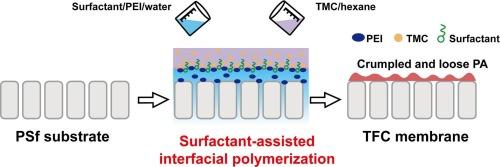表面活性剂在制造用于分离 Li+/Mg2+ 的聚酰胺纳滤膜中的多功能作用
IF 8.3
1区 工程技术
Q1 ENGINEERING, CHEMICAL
引用次数: 0
摘要
从盐湖卤水中提取锂可有效缓解全球锂短缺问题。从盐湖卤水中分离同时存在的 Mg2+ 离子和 Li+ 离子至关重要。虽然薄膜复合(TFC)纳滤(NF)膜显示出分离的潜力,但由于膜与阳离子之间的静电吸引力,表面带负电荷的商用 NF 膜无法满足对 Mg2+ 离子的高排斥要求。通过水相聚乙烯亚胺(PEI)和正己烷相三甲基甲酰氯(TMC)之间的界面聚合(IP)制造的带正电荷的 NF 膜已显示出分离 Li+/Mg2+ 的前景。然而,由于过度交联的结构导致膜的渗透率相对较低,锂排斥率较高,锂萃取效率受到很大限制。因此,有必要在保持 PEI/TMC 基 TFC 膜正电荷的同时优化其孔径。我们建议在 PEI 水溶液中添加阴离子表面活性剂,以调节 PEI/TMC 基 NF 膜的形成。表面活性剂通过相互作用控制 PEI 在 IP 中的扩散,并改善水-己烷界面的反应均匀性。这导致 PA 网络的孔径分布变窄。本研究使用了三种不同烷基链长度的硫酸盐表面活性剂来控制膜的形成。结果表明,最短的硫酸盐表面活性剂--正癸基硫酸钠(SDES)能最有效地改善膜性能。优化后的膜表面呈皱褶状,孔隙结构相对疏松,孔径分布较窄。它的纯水持久性为 5.65 L m-2 h-1 bar-1,对 MgCl2 的排斥率高达 92.6%,对 LiCl 的排斥率低至 21.5%。过滤 Mg2+ 和 Li+ 二元混合溶液后,Mg2+/Li+ 比率从 40(进水)显著降至 3.08(渗透水)。这项研究为制备具有良好 Li+/Mg2+ 分离性能的基于 PEI/TMC 的 NF 膜提供了一种有效的策略。本文章由计算机程序翻译,如有差异,请以英文原文为准。

Multifunctional role of surfactant in fabricating polyamide nanofiltration membranes for Li+/Mg2+ separation
Extracting Lithium from salt-lake brines can effectively alleviate global lithium scarcity. Separating the co-existing Mg2+ ions from Li+ ions in the brines is essential. While thin-film composite (TFC) nanofiltration (NF) membrane show potential for this separation, commercial NF membranes with negatively charged surfaces fail to meet the high rejection requirement for Mg2+ ions due to the electrostatic attractions between membranes and cations. Positively charged NF membranes fabricated by interfacial polymerization (IP) between aqueous phase polyethylenimine (PEI) and hexane phase trimesoyl chloride (TMC) have shown promise for Li+/Mg2+ separation. However, lithium extraction efficiency is greatly limited by the relatively low permeance and high lithium rejection of the membrane caused by an excessively cross-linked structure. Therefore, optimizing the pore size while maintaining the positive charge of PEI/TMC-based TFC membranes is necessary. We propose adding anionic surfactants to the aqueous PEI solution to modulate PEI/TMC-based NF membrane formation. Surfactants control PEI diffusion in IP through their interactions and improve reaction uniformity at the water-hexane interface. This results in a narrow pore size distribution of the PA network. In this study, three sulfate surfactants with varying alkyl chain lengths were used to control membrane formation. Results showed that sodium n-decyl sulfate (SDES), the shortest sulfate surfactant, improved membrane performance most effectively. The optimized membrane exhibited a crumpled surface and relatively loose pore structure with narrow pore size distribution. It demonstrated a pure water permanence of 5.65 L m−2 h−1 bar−1, high MgCl2 rejection of 92.6 %, and low LiCl rejection of 21.5 %. After filtering a Mg2+ and Li+ binary mixture solution, the Mg2+/Li+ ratio decreased significantly from 40 (feed) to 3.08 (permeate). This study provides an efficient strategy for preparing PEI/TMC-based NF membranes with favorable Li+/Mg2+ separation performance.
求助全文
通过发布文献求助,成功后即可免费获取论文全文。
去求助
来源期刊

Desalination
工程技术-工程:化工
CiteScore
14.60
自引率
20.20%
发文量
619
审稿时长
41 days
期刊介绍:
Desalination is a scholarly journal that focuses on the field of desalination materials, processes, and associated technologies. It encompasses a wide range of disciplines and aims to publish exceptional papers in this area.
The journal invites submissions that explicitly revolve around water desalting and its applications to various sources such as seawater, groundwater, and wastewater. It particularly encourages research on diverse desalination methods including thermal, membrane, sorption, and hybrid processes.
By providing a platform for innovative studies, Desalination aims to advance the understanding and development of desalination technologies, promoting sustainable solutions for water scarcity challenges.
 求助内容:
求助内容: 应助结果提醒方式:
应助结果提醒方式:


